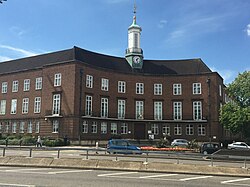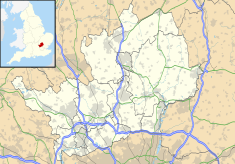Watford Town Hall is a municipal building in Rickmansworth Road, Watford, England. It is a Grade II listed building.[1]
| Watford Town Hall | |
|---|---|
 Watford Town Hall | |
| Location | Rickmansworth Road, Watford |
| Coordinates | 51°39′34″N 0°24′11″W / 51.6594°N 0.4031°W |
| Built | 1939 |
| Architect | Charles Cowles-Voysey |
| Architectural style(s) | Neo-Georgian style |
Listed Building – Grade II | |
| Designated | 21 December 1994 |
| Reference no. | 1251002 |
History
editIn the early 20th century Watford Urban District Council operated from municipal offices at Upton House in The Parade.[2] The council sought a proper town hall after it achieved municipal borough status in 1922.[3] The site proposed for the new building in Rickmansworth Road had previously been occupied by an old mansion known as "The Elms".[2] The foundation stone for the new building was laid by Rigby Taylor, the Mayor, in 1938.[4] The new building, which was designed by Charles Cowles-Voysey in the Neo-Georgian style,[5] was completed in 1939.[1] It was officially opened by the Countess of Clarendon on 5 January 1940.[4][6] The design involved a concave main frontage of seven bays facing Rickmansworth Road from which wings stretched back to the south west and north west; the central section featured a doorway with a wide cast iron balcony and a shield above; there was a clock with a lantern above at roof level.[1]
The facility also included a large public venue at the south west end of the complex initially known as "Watford Town Hall Assembly Rooms" but now referred to as the Watford Colosseum.[7]
During the Second World War, William Joyce, who as Lord Haw-Haw broadcast Nazi propaganda from Germany to the UK, criticised Watford Borough Council for the fact that the town hall clock was always two minutes slow.[8] Meanwhile British military forces carried out defensive exercises in case German invading forces ever stormed the town hall.[8]
In 1971 the Watford Peace Memorial, which had originally been constructed outside the Peace Memorial Hospital, was moved to a location on the Parade just outside the building.[9]
The town hall remains the headquarters of Watford Borough Council[10] which, in August 2019, initiated a consultation on a rejuvenation plan which could see the area around the town hall being turned into a "cultural hub" and the town hall itself being converted into a hotel.[11][12] The council indicated that, while the rest of the building might be redeveloped, the council chamber and committee rooms would be kept in their current use.[12]
References
edit- ^ a b c Historic England. "Watford Town Hall (1251002)". National Heritage List for England. Retrieved 7 July 2020.
- ^ a b Rabbitts, Paul; Jeffree, Peter (2019). Watford in 50 Buildings. Amberley Publishing. ISBN 978-1445690124.
- ^ "Watford". Vision of Britain. Retrieved 7 July 2020.
- ^ a b Forsyth, Mary (2015). Watford: A History. The History Press. ISBN 978-0750961592.
- ^ "Watford Town Hall, Hertfordshire". Royal Institute of British Architects. Retrieved 7 July 2020.
- ^ Cooper, John (2016). Watford History Tour. Amberley Publishing. ISBN 978-1445657776.
- ^ Scarbrough, Paul (6 March 2009). Acoustical Survey Report for the Watford Colosseum (PDF). Akustiks. Archived from the original (PDF) on 8 June 2013. Retrieved 9 February 2013.
- ^ a b "20 things you may not know about Watford during the Second World War". Watford Observer. 29 April 2014. Retrieved 8 July 2020.
- ^ Russell, Eugenia; Russell, Quentin (2015). Watford and South West Herts in the Great War. Pen and Sword. ISBN 978-1783463749.
- ^ "Watford Borough Council". The Law Pages. Retrieved 7 July 2020.
- ^ "Watford High Street and Cultural Hub Masterplan: Consultation opens for major town centre transformation". Hertfordshire Mercury. 16 August 2019. Retrieved 8 July 2020.
- ^ a b "Revealed: Bold plans to reshape town hall and Parade in Watford". Watford Observer. 27 June 2019. Retrieved 8 July 2020.
